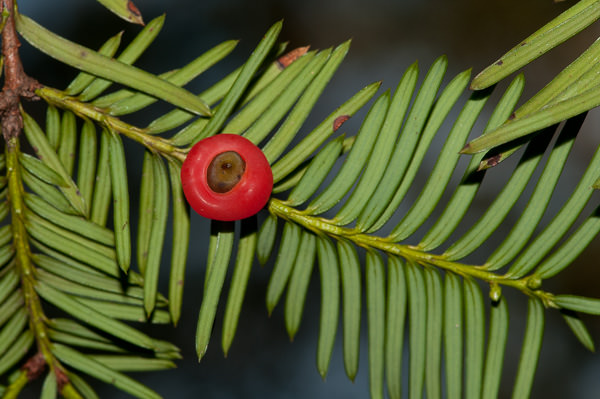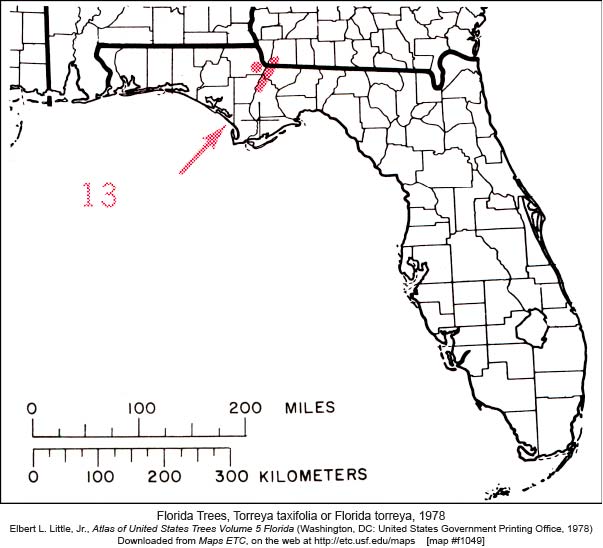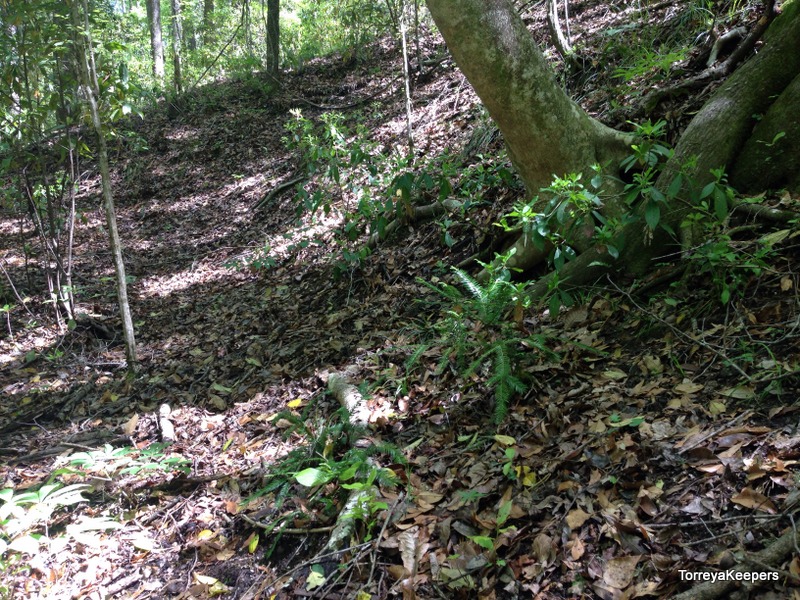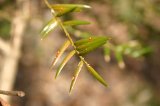How to identify a Florida Torreya
Florida Torreya (Torreya taxifolia) is an evergreen conifer. Its needle-like leaves are glossy dark green above, 0.5 to 1.5 inches long, stiff, prickly at the tips, arranged in flat sprays along the branch when fully developed. Disease-free trees can grow up to 60 feet tall in a conical shape with a trunk diameter of 1 foot or more and luxuriant whorled branches, but most trees in wild native habitat are root sprouts just a few feet tall, or if taller they lack lower branches or leaves on lower branches and the trunk may be less than 1 inch diameter. Trees are either male or female. Seeds on female trees are roundish green drupes about the size of a large olive. Tiny cones on male trees grow along branches. Seeds and cones are rarely seen in the wild. Visit our Flickr Album for more photos.
Click here to view our brochure on Identifying Torreya taxifolia
(Click on an image to enlarge it.)
Comparison with other conifers
The Florida yew (Taxus floridana) shares the same habitat as the Florida Torreya, is also a very rare tree, and has needles very similar to the Torreya's. Florida yew needles are soft to the touch, the branches do not grow in whorls, and the fruit are small fleshy red cups around a seed. The bark is dark reddish colored. It tends to grow in colonies. TorreyaKeepers are also documenting Florida yew.

Young red cedars (Juniperus virginiana) can be confused with Torreya. They do not have flat sprays of long needles.
The China fir (Cunninghamia lanceolata) closely resembles the Florida Torreya. It was brought from China for use as an ornamental landscape plant, and mature trees are sometimes seen in yards and old homesteads. If you think you have spotted a large, healthy-looking Torreya tree in someone’s yard, it is probably a China fir!
Disease
The deadly fungus has been identified as Fusarium torreyae, and is thought to be imported from Asia. Disease symptoms are needles that are lighter in color, yellow, or absent and/or cankers on the trunk or branches. This fungus appears to be ubiquitous in the ravines area. Root sprouts die before reaching maturity and producing fruit, so the species will go extinct in the wild without intervention.
Where are Florida Torreya trees found?
Wild Florida Torreya trees live primarily in the central Florida Panhandle, in the Apalachicola River bluffs and ravines region. They occur in the northwest corner of Liberty County and the western side of Gadsden County. They extend just into the southwest corner of Decatur County, Georgia. A population previously known, across the river in Jackson County adjacent to Dog Pond, southwest of Ocheesee Pond, no longer exists.
The northern and eastern limits of the tree’s range are not precisely known.
A series of range maps through the years is shown here.
Florida Trees, Torreya taxifolia or Florida torreya, 1978

Range of Torreya taxifolia, from E.L. Little, Jr., "Atlas of United States Trees" Vol. 5: Florida
What is Florida Torreya habitat?
Florida Torreya trees grow in shady ravines with seepage streams along the bottom, or on bluffs of the Apalachicola River.These upland areas have a rich diversity of hardwood trees and shrubs. The natural community is called slope forest and is one of Florida’s rarest natural communties. Read the Florida Natural Areas Inventory's description of the slope forest natural community here (PDF).








